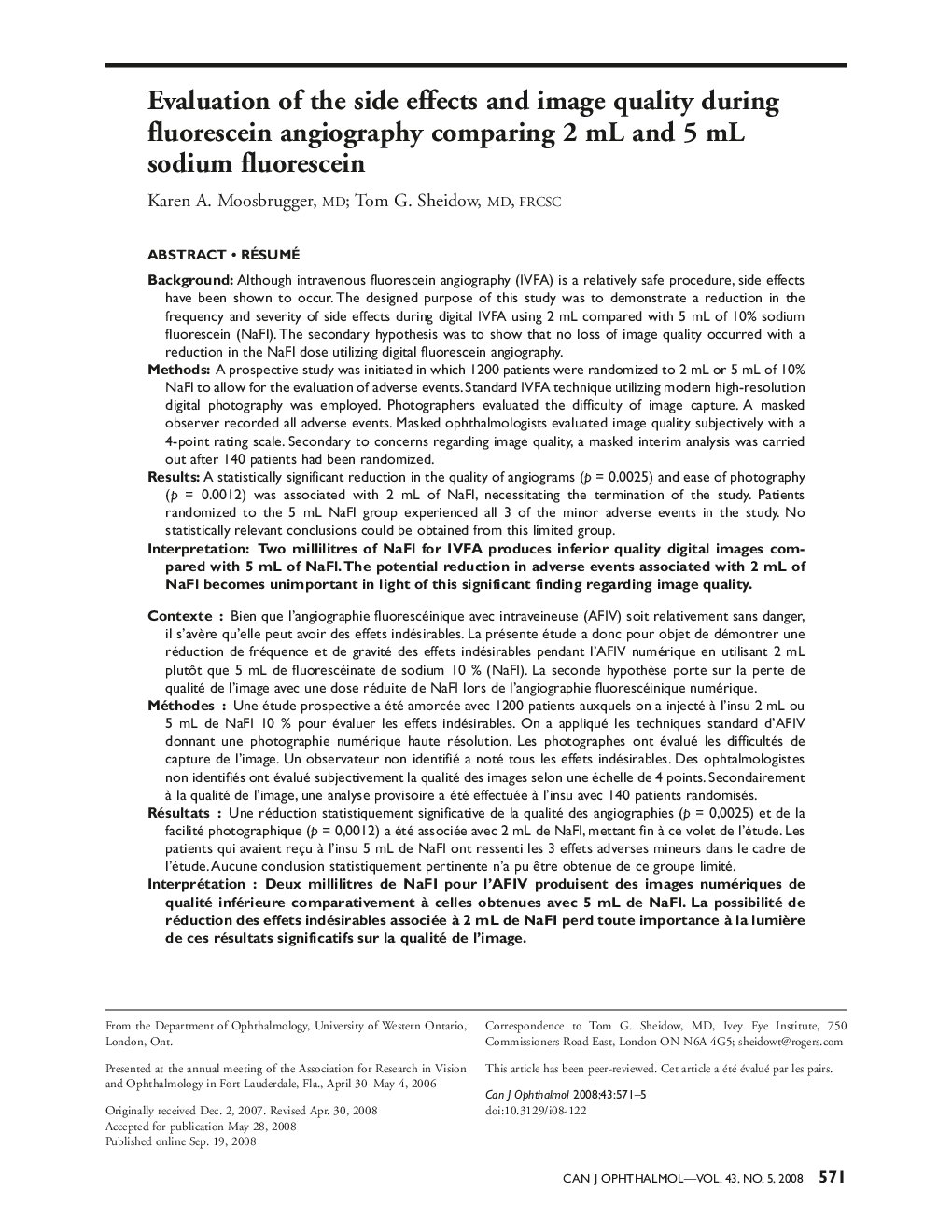| Article ID | Journal | Published Year | Pages | File Type |
|---|---|---|---|---|
| 4010026 | Canadian Journal of Ophthalmology / Journal Canadien d'Ophtalmologie | 2008 | 5 Pages |
Background: Although intravenous fluorescein angiography (IVFA) is a relatively safe procedure, side effects have been shown to occur. The designed purpose of this study was to demonstrate a reduction in the frequency and severity of side effects during digital IVFA using 2 mL compared with 5 mL of 10% sodium fluorescein (NaFl). The secondary hypothesis was to show that no loss of image quality occurred with a reduction in the NaFl dose utilizing digital fluorescein angiography.Methods: A prospective study was initiated in which 1200 patients were randomized to 2 mL or 5 mL of 10% NaFl to allow for the evaluation of adverse events. Standard IVFA technique utilizing modern high-resolution digital photography was employed. Photographers evaluated the difficulty of image capture. A masked observer recorded all adverse events. Masked ophthalmologists evaluated image quality subjectively with a 4-point rating scale. Secondary to concerns regarding image quality, a masked interim analysis was carried out after 140 patients had been randomized.Results: A statistically significant reduction in the quality of angiograms (p = 0.0025) and ease of photography (p = 0.0012) was associated with 2 mL of NaFl, necessitating the termination of the study. Patients randomized to the 5 mL NaFl group experienced all 3 of the minor adverse events in the study. No statistically relevant conclusions could be obtained from this limited group.Interpretation: Two millilitres of NaFl for IVFA produces inferior quality digital images compared with 5 mL of NaFl. The potential reduction in adverse events associated with 2 mL of NaFl becomes unimportant in light of this significant finding regarding image quality.
RésuméContexte: Bien que l’angiographie fluorescéinique avec intraveineuse (AFIV) soit relativement sans danger, il s’avère qu’elle peut avoir des effets indésirables. La présente étude a donc pour objet de démontrer une réduction de fréquence et de gravité des effets indésirables pendant l’AFIV numérique en utilisant 2 mL plutôt que 5 mL de fluorescéinate de sodium 10% (NaFl). La seconde hypothèse porte sur la perte de qualité de l’image avec une dose réduite de NaFl lors de l’angiographie fluorescéinique numérique.Méthodes: Une étude prospective a été amorcée avec 1200 patients auxquels on a injecté à l’insu 2 mL ou 5 mL de NaFl 10% pour évaluer les effets indésirables. On a appliqué les techniques standard d’AFIV donnant une photographie numérique haute résolution. Les photographes ont évalué les difficultés de capture de l’image. Un observateur non identifié a noté tous les effets indésirables. Des ophtalmologistes non identifiés ont évalué subjectivement la qualité des images selon une échelle de 4 points. Secondairement à la qualité de l’image, une analyse provisoire a été effectuée à l’insu avec 140 patients randomisés.Résultats: Une réduction statistiquement significative de la qualité des angiographies (p = 0,0025) et de la facilité photographique (p = 0,0012) a été associée avec 2 mL de NaFl, mettant fin à ce volet de l’étude. Les patients qui avaient reçu à l’insu 5 mL de NaFl ont ressenti les 3 effets adverses mineurs dans le cadre de l’étude. Aucune conclusion statistiquement pertinente n’a pu être obtenue de ce groupe limité.Interprétation: Deux millilitres de NaFl pour l’AFIV produisent des images numériques de qualité inférieure comparativement à celles obtenues avec 5 mL de NaFl. La possibilité de réduction des effets indésirables associée à 2 mL de NaFl perd toute importance à la lumière de ces résultats significatifs sur la qualité de l’image.
